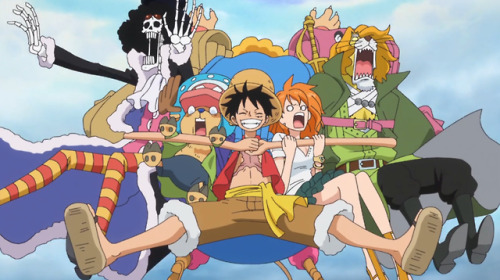 |
| Primary antagonist Big Mom |
One Piece's Wano Arc is in full swing for both the manga and the anime series, and fans of Japan's favourite comic franchise are loving all of the spectacular samurai action - but let's not forget what came before! Before Luffy and the Straw Hat Pirates arrived in the Land of Wano, they were battling Emperor Big Mom on her home turf to free their chef Sanji from a forced marriage. So, looking back, just how good was the Whole Cake Island Arc?
The main thing that jumps out about Whole Cake is that it continues to burst with the creativity and flavour that make One Piece so beloved. Whole Cake Island itself is the centrepiece of an archipelago known collectively as Totto Land, each corresponding to a delicious treat, such as cheese, pie, biscuits and candy. These islands are populated by Big Mom's forces and various super-powered commanders, making it a daunting task for Luffy's rescue team to make it in and out unscathed.
 |
| Sanj's family run the revered military force Germa 66 |
Tons of new characters are introduced throughout the storyline, including Big Mom and her 85 children, Sanji's relatives in the Vinsmoke Family, and more members of the Fire Tank crew (who were originally shown during the seminal Paramount War saga). This might make the story sound like an absolute mess, but somehow creator Eiichiro Oda manages to ease all of these into the story naturally, and spare plenty of time for all of the most important ones to be fleshed out. How on earth does he do it?
The huge scope adds so much weight to the all-out war that breaks out during the final volumes of the 9-part adventure, with lots of exciting action and plenty of moments that give you a lump in your throat. However, Whole Cake saves the final battle with Big Mom for another time, using this story as a means of demonstrating just how powerful Emperors and their followers are.
 |
| Katakuri's bounty of over one billion was the highest shown at this point in the series |
Instead, this arc's big battle is between Luffy and Sweet Commander Katakuri, the second son of Big Mom. Having eaten the Mochi-Mochi Fruit, named after Japanese rice cakes, Katakuri has a stretchy power similar to Luffy's. Combine this with the staggering height inherited from his mother, and a foresight ability he's trained so hard to perfect, this new villain is superior to Luffy is nearly every way, posing a big challenge for our hero.
Their fight is definitely the start of another classic Shonen manga rivalry - Katakuri is a compelling character with one of the best designs in the series, so fans should be certain this isn't the last time we'll see him. Another thing that will carry over from this conflict is Luffy's awesome new 'Snakeman' form, activated for the first time against his most powerful combatant yet. This sleek new version of Gear Four is even cooler than its original look, giving Luffy a necessary power boost prior to Wano.
 |
| Snakeman is a much faster version of Luffy's Gear Four transformation |
Oda's art in these volumes is some of the finest we've seen yet, being the latest stage in an evolved art style that lends itself extremely well to high-adrenaline battles and intriguing surroundings. In one of the final chapters, 'Bad End Musical', Oda uses words and pictures to cleverly create music. This chilling song, performed by Big Mom, is one of the most memorable parts of the arc and works really well.
Despite its many shake-ups, the Whole Cake Island Arc still adheres to the One Piece formula fans have come to expect over the years: arriving in an exciting new place, realising not all is what it seems, then confronting the tyrannical leader. Much of the story beats are extremely similar to the preceding Dressrosa saga - in fact, it could even be described by some as the "Dressrosa Aftermath Arc", or the "Road to Wano".
 |
| Part of Luffy's team to rescue Sanji |
As the Straw Hat crew was split in half at the end of Dressrosa, fans of Zoro, Usopp, Robin and Franky will perhaps be a little frustrated about having to go 78 chapters (or 95 anime episodes) without seeing their favourite pirates. Nonetheless, this time is well spent developing Sanji, with a backstory that expands on the beloved character massively.
Whole Cake is also an unmissable story in how it officially introduces the first new crew member in ten years: Jimbei, who previously declined to join during the Fishman Island Arc due to "unfinished business". While Jimbei still isn't able to sail with Luffy and the others just yet, him becoming the tenth Straw Hat Pirate is a big step forward for the franchise.
 |
| "I am your captain now!" |
This arc is certainly as creative, engaging and moving as One Piece fans have come to expect, but isn't quite as thought-provoking as it has shown it can be. Still, it appears a contender to surpass big storylines like Paramount War and Water Seven is on the horizon, as the epilogue of this arc dives back into the political commentary, brings back fan-favourites and possibly even hints at the final antagonist.
Overall, the Whole Cake Island Arc is a great example of why One Piece has consistently been one of the best comics on the shelves for the past 22 years, and it looks like it's going to get even better from here on out. Set sail for Wano!
Rating: 8.5/10
The complete Whole Cake Island Arc is available now in print volumes 82 - 90. Alternatively, you can catch up on the story by reading chapters 825 - 902 on the official Shonen Jump app. Anime watchers can follow the story on their screens as episodes 783 - 877.

Comments
Post a Comment